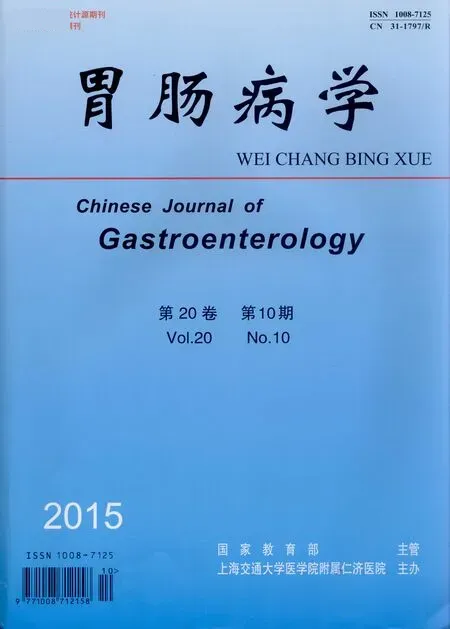Wnt信号转导通路与结直肠癌的研究进展
李伶俐 陈小燕 朱 蓉 赵 逵*
遵义医学院(563003)1 遵义医学院附属医院消化内科2
Wnt信号转导通路与结直肠癌的研究进展
李伶俐1陈小燕2朱蓉2赵逵2*
遵义医学院(563003)1遵义医学院附属医院消化内科2

结直肠癌是胃肠道最常见的恶性肿瘤之一,发病机制尚未完全明确,目前认为是一个多步骤、多阶段参与的疾病。Wnt信号转导通路是进化上高度保守的信号系统,可调控细胞生长、运动和分化,且在胚胎发育、肿瘤发生等过程中起重要作用。人类多种恶性肿瘤中均存在Wnt通路异常,90%以上的结直肠癌存在Wnt经典信号转导通路激活[1]。本文就Wnt信号转导通路与结直肠癌的研究进展作一综述。
一、Wnt信号转导通路
1. Wnt经典信号转导通路:Wnt经典信号转导通路即Wnt/β-catenin通路。Wnt通路的模式是:无Wnt信号时,降解复合体与β-catenin结合使其磷酸化,β-catenin随即脱离复合体,通过β-转导重复相容蛋白(β-TrCP)泛素化,从而被蛋白酶体降解;Wnt信号刺激时,Wnt信号诱导轴蛋白(Axin)与磷酸化的低密度脂蛋白受体相关蛋白(LRP)结合,降解复合体分离,β-catenin在胞质中稳定存在,并转位入胞核,与T细胞因子(TCF)结合,形成转录复合体,激活Lgr5等靶基因。近年来,基于内源性降解复合体的研究提出一种新的Wnt信号转导通路模式:无Wnt信号时,降解复合体通过β-TrCP与β-catenin结合,使其磷酸化和泛素化后被降解;Wnt信号刺激时,降解复合物与磷酸化LRP结合,然后结合β-catenin使其磷酸化,但此过程可被β-TrCP泛素化阻止,导致β-catenin在胞质内积聚[2]。
2. Wnt非经典信号转导通路:目前有多种Wnt非经典通路,如Wnt/PCP、Wnt-RAP1、Wnt-Ror2、Wnt-PKA、Wnt-GSK3MT、Wnt-aPKC、Wnt-RYK、Wnt-mTOR以及Wnt/Ca2+、Wnt/Wg等,多种通路可重叠出现。其中Wnt/Ca2+通路尤为重要,其由Wnt5a或Wnt4激活后可抑制包括结直肠癌在内的多种肿瘤[3]。
二、Wnt信号转导通路主要组成成分
1. Wnt蛋白:①Wnt蛋白脂酰化修饰:Wnt蛋白中高度保守的半胱氨酸与棕榈酸酯通过硫脂键结合后被脂酰化[4]。研究[5-6]发现,Wnt蛋白去除半胱氨酸后,活性丧失,提示Wnt蛋白活性受脂酰化调控。②Wnt蛋白的转运:Wls是7次跨膜蛋白,存在于高尔基体网络、核内体和质膜,可与Wnt蛋白结合,将Wnt蛋白从高尔基体运至质膜,且对Wnt蛋白稳定分泌起重要作用。研究[7]显示,胞内转运复合体retromer亦对Wnt信号途径十分重要,其参与Wnt蛋白的转运,通过逆向转运将核内体中的Wls运回至高尔基网络,从而避免被溶酶体降解。
2. β-catenin:β-catenin 是Wnt/β-catenin通路的中枢成分。正常成熟细胞中,大部分β-catenin与细胞膜上的E-钙黏蛋白结合,参与细胞间黏附、生长、增殖等过程,少部分与胞质降解复合体结合被降解。β-catenin的黏附作用和信号转 导功能独立存在[8]。Wnt信号活化可提高β-catenin水平[9]。
三、Wnt信号转导通路的调节
1. β-catenin对Wnt通路的调节:降解复合体可调控胞质内β-catenin的稳定性,后者对经典Wnt信号转导通路起关键作用[10]。β-catenin降解复合体可使β-catenin磷酸化,而后被泛素-蛋白酶体系统降解,使其保持低水平,从而关闭Wnt通路[11]。WTX是一种抑癌蛋白,参与β-catenin降解复合体功能,促进β-catenin降解,发挥抑癌作用。目前关于WTX在Wnt通路中的作用存在争议[12]。
2. Lgr对Wnt通路的调节:Glinka等[13]的研究显示,Lgr4、Lgr5是R-脊柱蛋白受体,其可介导R-脊柱蛋白参与Wnt经典信号通路。在生殖器、眼睛、膀胱、肾、毛囊、下颚、舌头、胃、肠道等多种器官中均有Lgr4、Lgr5表达[14-16]。对胃肠道肿瘤的研究[15]发现,Lgr5是Wnt通路的靶基因,胃肠道中Lgr5阳性表达的干细胞可发挥组织重建作用。Walker等[17]对结直肠癌细胞株的研究显示,Lgr5可拮抗Wnt信号,调控细胞黏附,抑制肿瘤生长。
3. 金属结合蛋白(Dpr)对Wnt通路的调节:Dpr的功能域在进化上高度保守,对于调控Wnt信号的机制尚未明确。Dpr可与散乱蛋白(DSH)结合,诱导DSH在溶酶体中降解,从而抑制Wnt经典通路和非经典通路激活[18]。Gao等[19]亦发现Dpr1能同时负性调控细胞质和细胞核中的Wnt信号途径。但是,Gloy等[20]对爪蟾的研究显示,Dpr1能协同加强DSH的作用。因此,Dpr1对Wnt信号通路的调节作用尚存争议。
四、Wnt通路与结直肠癌的关系
1. 基因异常:①β-catenin基因突变:β-catenin基因缺失或突变导致β-catenin不能降解,在胞质内积累,引起肿瘤发生。虽然β-catenin基因突变可导致Wnt信号活化,但大多数结肠癌患者显示了β-catenin的异质性,表明Wnt信号调控的复杂性[21]。②APC基因突变:多数结直肠癌存在APC基因缺失突变或失活[22]。APC基因突变点位于与Axin结合位点,产生截短APC蛋白,导致不能形成降解复合体降解β-catenin。APC功能缺失不仅导致β-catenin聚积,亦促进β-catenin与TCF4形成 TCF/β-catenin复合物,激活Wnt信号转导通路下游的靶基因。Yoshie等[23]用气相色谱法比较表达正常APC蛋白和截短APC蛋白的SW480结直肠癌细胞代谢物含量,结果显示,表达截短APC蛋白的SW480细胞的代谢产物含量明显提高,提示APC突变通过改变能量代谢通路参与结直肠癌的发展。此外,Bellis等[24]的研究表明,APC突变的小鼠腺瘤细胞中,干细胞不对称分裂发生改变,此为结直肠癌的发展提供了新线索。③Axin基因突变:结直肠癌细胞株中Axin表达缺失可导致β-catenin大量积聚,从而引起Wnt信号通路异常活跃。Vermeulen等[21]通过研究克什米尔人群中结直肠癌患者的Axin基因突变模式发现,Axin1和Axin2基因突变参与了结直肠癌的发生和发展,并发现Axin2基因突变可能是克什米尔人群患结直肠癌的诱发因素。
2. Wnt信号通路与结直肠癌干细胞:肿瘤干细胞能够自我更新以及维持分化潜能,其行为需依赖外部信号,如Wnt信号[25]。研究显示,Wnt非经典途径可拮抗β-catenin依赖的转录,表明其有抗癌作用[26]。近年来,大量研究证实,Wnt信号、干细胞信号及以肿瘤干细胞行为间存在联系,提示干细胞生物学与结直肠癌相关。
①肠道干细胞与结直肠癌干细胞:在自我更新以及多向分化潜能方面,肿瘤干细胞与干细胞具有相似的生物学特性。肿瘤干细胞学说认为,肿瘤干细胞可能源于正常干细胞的累积突变和(或)祖细胞通过基因突变重新获得自我更新能力。肿瘤干细胞可能带有正常干细胞/祖细胞的特异性表面标记物,如结肠癌干细胞具有与结肠干细胞相同的标记物如CD133、Lgr5。
②Wnt信号通路与结肠干细胞:正常人结肠由数百万个隐窝组成,每个隐窝含有2 000个细胞。干细胞位于隐窝基底部,每个隐窝约有5~10个干细胞[27-28]。肌成纤维细胞可通过调控Wnt信号对肝配蛋白B1(EFNB1)、EPHB2以及EPHB3作用,从而调节干细胞功能。Wnt信号通路亦对结肠干细胞自我更新的调控起重要作用[29-30]。此外,Lgr蛋白作为R-脊柱蛋白受体可介导Wnt信号与干细胞紧密联系。通过抑制TCF4或给予Wnt拮抗剂Dickkopf-1(DDK1)阻断Wnt信号,导致上皮细胞增殖能力减弱。
③Wnt信号通路与结肠癌干细胞:Wnt/β-catenin通路可调控肿瘤细胞的生长。研究[29]指出,结肠癌细胞球可减少β-catenin在细胞膜黏附,提高β-catenin、cyclin D1以及c-myc的胞质水平,同时下调Axin1和磷酸化β-catenin。β-catenin表达增多与TCF/LEF转录活化密切相关,采用RNA干扰技术使β-catenin基因沉默,可导致TCF/LEF降低,从而减少结肠癌细胞球形成。相反,上调c-myc和TCF/LEF下游效应器可大幅增加结肠癌球囊细胞生成。Barker等[30]通过敲除小鼠Lgr5-Cre+肠隐窝干细胞的APC基因,发现3~5周后干细胞仍存留于隐窝底部,并形成肉眼可见的Lgr5+腺瘤,提示Wnt信号转导通路参与正常肠干细胞向肿瘤干细胞转化。
五、结语
基于Wnt信号转导通路是一条多环节、多作用位点的开放通路,其对结直肠癌的发生、发展尤为重要,因此可针对该信号途径进行分子靶向治疗。然而,结直肠癌的发生是一个复杂的网络工程,Wnt信号转导通路的作用机制以及Wnt信号转导通路与其他信号通路如STATs 、MAPKs、Hedgehog、BMP等的相互作用机制尚未完全明确,仍有待进一步研究。
参考文献
1 Silva AL, Dawson SN, Arends MJ, et al. Boosting Wnt activity during colorectal cancer progression through selective hypermethylation of Wnt signaling antagonists[J]. BMC Cancer, 2014, 14: 891.
2 Li VS, Ng SS, Boersema PJ, et al. Wnt signaling through inhibition of β-catenin degradation in an intact Axin1 complex[J]. Cell, 2012, 149 (6): 1245-1256.
3 De A. Wnt/Ca2+ signaling pathway: a brief overview[J]. Acta biochim biophys Sin (Shanghai), 2011, 43 (10): 745-756.
4 Takada R, Satomi Y, Kurata T, et al. Monouns aturated fatty acid modification of Wnt protein: its role in Wnt secretion[J]. Dev Cell, 2006, 11 (6): 791-801.
5 Willert K, Brown JD, Danenberg E, et al. Wnt proteins are lipid-modified and can act as stem cell growth factors[J]. Nature, 2003, 423 (6938): 448-451.
6 Janda C, Waghray D, Levin AM, et al. Structural basis of Wnt recognition by Frizzled[J]. Science, 2012, 337 (6090): 59-64.
7 Port F, Kuster M, Herr P, et al. Wingless secretion promotes and requires retromer-dependent cycling of Wntless[J]. Nat Cell Biol, 2008, 10 (2): 178-185.
8 Clevers H, Nusse R. Wnt/β-catenin signaling and disease[J]. Cell, 2012, 149 (6): 1192-1205.
9 Goentoro L, Kirschner MW. Evidence that fold-change, and not absolute level, of beta-catenin dictates Wnt signaling[J]. Mol Cell, 2009, 36 (5): 872-884.
10Krausova M, Korinek V. Wnt signaling in adult intestinal stem cells and cancer[J]. Cell Sign, 2014, 26 (3): 570-579.
11Tan CW, Gardiner BS, Hirokawa Y, et al. Analysis of Wnt signaling β-catenin spatial dynamics in HEK293T cells[J]. BMC Syst Biol, 2014, 8 (1): 1-34.
12Regimbald-Dumas Y, He X. Wnt signalling:What The X@# is WTX?[J]. EMBO J, 2011, 30 (8): 1415-1417.
13Glinka A, Dolde C, Kirsch N, et al. LGR4 and LGR5 are R-spondin receptors mediating Wnt/β-catenin and Wnt/PCP signalling[J]. EMBO Rep, 2011, 12 (10): 1055-1061.
14Barker N, Clevers H. Leucine-rich repeat-containing G-protein-coupled receptors as markers of adult stem cells[J]. Gastroenterology, 2010, 138 (5): 1681-1696.
15Barker N, Huch M, Kujala P, et al. Lgr5(+ve) stem cells drive self-renewal in the stomach and build long-lived gastric unitsinvitro[J]. Cell Stem Cell, 2010, 6 (1): 25-36.
16Mustata RC, Van Loy T, Lefort A, et al. Lgr4 is required for Paneth cell differentiation and maintenance of intestinal stem cellsexvivo[J]. EMBO Rep, 2011, 12 (6): 558-564.
17Walker F, Zhang HH, Odorizzi A, et al. LGR5 is a negative regulator of tumourigenicity, antagonizes wnt signalling and regulates cell adhesion in colorectal cancer cell lines[J]. PLoS One, 2011, 6 (7): e22733.
18Cheyette BNR, Waxman JS, Miller JR, et al. Dapper, a Dishevelled-associated antagonist of beta-Catenin and JNK signaling, is required for Notochord formation[J]. Developmental Cell, 2002, 2 (4): 449-461.
19Gao X, Wen J, Zhang L, et al. Dapper1 is a nucleocyto-plasmic shuttling protein that negatively modulates wnt signaling in the nucleus[J]. J Biol Chem, 2008, 283 (51): 35679-35688.
20Gloy J, Hikasa H, Sokol SY. Frodo interacts with Dishevelled to transduce Wnt signals[J]. Nat Cell Biol, 2002, 4 (5): 351-357.
21Vermeulen L, De Sousa E Melo F, van der Heijden M, et al. Wnt activity defines colon cancer stem cells and is regulated by the microenvironment[J]. Nat Cell Biol, 2010, 12 (5): 468-476.
22Wood LD, Parsons DW, Jones S, et al. The genomic landscapes of human breast and colorectal cancers[J]. Science, 2007, 318 (5853): 1108-1113.
23Yoshie T, Nishiumi S, Izumi Y, et al. Regulation of the metabolite profile by an APC gene mutation in colorectal cancer[J]. Cancer Sci, 2012, 103 (6): 1010-1021.
24Bellis J, Duluc I, Romagnolo B, et al. The tumor suppressor Apc controls planar cell polarities central to gut homeostasis[J]. J Cell Biol, 2012, 198 (3): 331-341.
25Clevers H, Nusse R. Wnt/β-catenin signaling and disease[J]. Cell, 2012, 149 (6): 1192-1205.
26Kühl M,Sheldahl LC,Park M, et al. The Wnt/Ca2+ pathway: a new vertebrate Wnt signaling pathway takes shape[J]. Trends in Genetics, 2000, 16 (7): 279-283.
27Roy S, Majumdar AP. Signaling in colon cancer stem cells[J]. J Mol Signal, 2012, 7 (1): 11.
28Willis ND, Przyborski SA, Hutchison CJ, et al. Colonic and colorectal cancer stem cells: progress in the search for putative biomarkers[J]. J Anat, 2008, 213 (1): 59-65.
29Kanwar SS, Yu Y, Nautiyal J, et al. The Wnt/beta-catenin pathway regulates growth and maintenance of colonospheres[J]. Mol Cancer, 2010, 9: 212.
30Barker N, Ridgway RA, van Es JH, et al. Crypt stem cells as the cells-of-origin of intestinal cancer[J]. Nature, 2009, 457 (7229): 608-611.
(2015-01-28收稿;2015-02-05修回)
·病例分析与个案报道·
摘要结直肠癌是胃肠道最常见的恶性肿瘤之一,发病机制尚未完全明确,目前认为是一个多步骤、多阶段参与的疾病。Wnt信号转导通路可调控细胞生长、运动和分化,且在胚胎发育、肿瘤发生等过程中起重要作用。本文就Wnt信号转导通路与结直肠癌的研究进展作一综述。
关键词结直肠肿瘤;Wnt信号通路;β连环素;干细胞
Advances in Study on Wnt Signaling Transduction Pathway and Colorectal CancerLILingli1,CHENXiaoyan2,ZHURong2,ZHAOKui2.1ZunyiMedicalCollege,Zunyi,GuizhouProvince(563003);2DepartmentofGastroenterology,AffiliatedHospitalofZunyiMedicalCollege,Zunyi,GuizhouProvince
Correspondence to: ZHAO Kui, Email: kuizhao95868@msn.com
AbstractColorectal cancer is one of the most commonly seen gastrointestinal carcinomas and its pathogenesis has not yet been fully clarified. It is considered as a multi-step and multi-stage disease. Wnt signaling transduction pathway regulates cell growth, motility and differentiation, and plays a crucial role in the regulation of embryonic development and tumor genesis. This article reviewed the advances in study on Wnt signaling transduction pathway and colorectal cancer.
Key wordsColorectal Neoplasms;Wnt Signaling Pathway;beta Catenin;Stem Cells
通信作者*本文,Email: kuizhao95868@msn.com
DOI:10.3969/j.issn.1008-7125.2015.10.015

